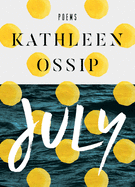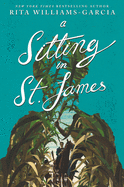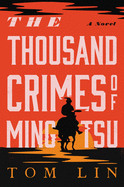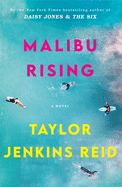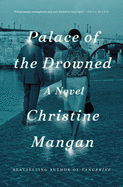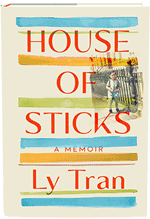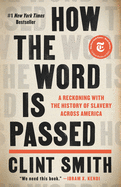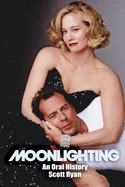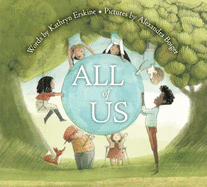Tuesday, June 1, 2021
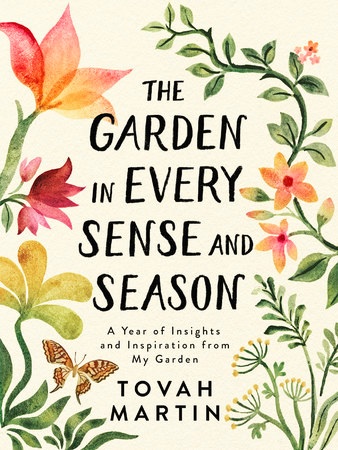 As we emerge from both winter and the pandemic, I've been delighting in blooming trees and green, growing plants--and reaching for books that inspire me to pay attention to the natural world. Tovah Martin's The Garden in Every Sense and Season (Timber Press, $16.95) is a joyful tour through a year in the garden, with brief essays highlighting particular plants. Through the lens of the five senses, Martin encourages readers to dig (literally) into the dirt and let the plant kingdom restore their souls.
As we emerge from both winter and the pandemic, I've been delighting in blooming trees and green, growing plants--and reaching for books that inspire me to pay attention to the natural world. Tovah Martin's The Garden in Every Sense and Season (Timber Press, $16.95) is a joyful tour through a year in the garden, with brief essays highlighting particular plants. Through the lens of the five senses, Martin encourages readers to dig (literally) into the dirt and let the plant kingdom restore their souls.
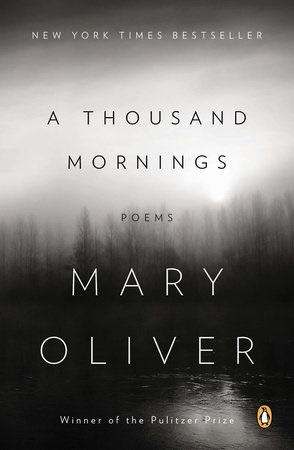 I always return to Mary Oliver in the spring. Her collections, including Thirst, Why I Wake Early (Beacon Press, $16 each), A Thousand Mornings (Penguin, $17) and others, prompt me to notice birds, trees, flowers and other wildlife in my neighborhood. Oliver's keen eye for detail and unsentimental imagery--she celebrates nature's darkness as much as its light--helps sharpen my own eyes and soul.
I always return to Mary Oliver in the spring. Her collections, including Thirst, Why I Wake Early (Beacon Press, $16 each), A Thousand Mornings (Penguin, $17) and others, prompt me to notice birds, trees, flowers and other wildlife in my neighborhood. Oliver's keen eye for detail and unsentimental imagery--she celebrates nature's darkness as much as its light--helps sharpen my own eyes and soul.
 This winter's PBS series based on James Herriot's memoirs prompted me to pick them up again, starting with All Creatures Great and Small (St. Martin's, $8.99). Herriot's wry accounts of his life in rural Yorkshire, serving as a veterinarian to pets and farm animals, are full of colorful characters. His vivid writing celebrates growth and rebirth while acknowledging the necessary rhythms of the seasons: he loves the Yorkshire Dales and their residents, human and animal, as much in deep winter as he does in full green summer.
This winter's PBS series based on James Herriot's memoirs prompted me to pick them up again, starting with All Creatures Great and Small (St. Martin's, $8.99). Herriot's wry accounts of his life in rural Yorkshire, serving as a veterinarian to pets and farm animals, are full of colorful characters. His vivid writing celebrates growth and rebirth while acknowledging the necessary rhythms of the seasons: he loves the Yorkshire Dales and their residents, human and animal, as much in deep winter as he does in full green summer.
 Finally, Robert Macfarlane's The Lost Spells (Anansi, $26), gorgeously illustrated by Jackie Morris, is a celebration of creatures with whom we humans share our world. Moths, owls, curlews, foxes and others flit in and out of the pages, their elusive magic captured by Macfarlane's pen and Morris's brush. Each of these books brings home the truth of Oliver's famous line: "Attention is the beginning of devotion." --Katie Noah Gibson, blogger at Cakes, Tea and Dreams
Finally, Robert Macfarlane's The Lost Spells (Anansi, $26), gorgeously illustrated by Jackie Morris, is a celebration of creatures with whom we humans share our world. Moths, owls, curlews, foxes and others flit in and out of the pages, their elusive magic captured by Macfarlane's pen and Morris's brush. Each of these books brings home the truth of Oliver's famous line: "Attention is the beginning of devotion." --Katie Noah Gibson, blogger at Cakes, Tea and Dreams
Shoko's Smile
by Choi Eunyoung, transl. by Sung Ryu
Women alone populate the extraordinary seven stories in Shoko's Smile by bestselling Korean author Choi Eunyoung, who makes her English-language debut, smoothly translated by Sung Ryu. From daughters to grandmothers, Choi's narrators remain in motion, not only physically but chronologically, each assessing significant past events that shape their current lives.
In the first three stories, childhood experiences create lingering effects deep into adulthood. In the titular "Shoko's Smile," a Japanese student's visit with her Korean host family will engender an epistolary relationship that lasts decades. In "Xin Chào, Xin Chào," a Korean woman recalls her family's close friendship with a Vietnamese family while living in Germany. A woman is visited in her hospital bed by the 16-year-old version of a cousin with whom she shared a close bond as a child, in "Sister, My Little Soonae."
Suddenly truncated relationships haunt "Hanji and Youngju" (about a Korean geology graduate student and a Nairobi vet who develop an intense friendship while living in a French monastery) and also "A Song from Afar" (featuring a Korean woman who arrives in St. Petersburg to visit an older schoolmate who studied Russian literature). Missing loved ones dominate "Michaela," about a mother who visits Seoul to glimpse her hardworking daughter, as well as "The Secret," in which a grandmother faces death without her beloved granddaughter; the 2014 Sewol ferry disaster looms in both.
Choi writes assuredly, her sentences direct and unadorned, yet the simplicity belies intricate narratives often hinging on unpredictable details--a nipple caterpillar tattoo, an Antarctic burial, a 1997 cassette tape. As they long, endure, transform (and not), Choi's exceptional women are well-primed for their close-up. --Terry Hong, Smithsonian BookDragon
Discover: Choi Eunyoung's remarkable debut collection features seven stories of Korean women, candidly assessing their lives past and present.
The Thousand Crimes of Ming Tsu
by Tom Lin
Warning: the number of corpses could actually exceed the page count in Tom Lin's addictively gruesome debut, The Thousand Crimes of Ming Tsu. Set between the Utah Territories and California in the late 1800s, Lin's novel manages to enhance a wild, wild western with Odyssean devotion, magic realism and historical racism, to create quite the unlikely love story gone awry.
Orphan Ming Tsu doesn't remember his immigrant Chinese parents; he was raised instead by a "caretaker" who "treated [him] like a son" but also trained him to be an efficient killer. Ming carries a notebook in which six scribbled names will determine his destiny: a labor recruiter, a gang boss, a sheriff, a judge, two brothers, each of whom helped shatter his life 10 years ago by stealing his wife, Ada, and damning him to railroad chain gang labor. Accompanied by a blind, death-foretelling Chinese "prophet," Ming will methodically wreak revenge.
For all his life, Lin's protagonist has seemingly discarded his Chinese roots--raised by a white man, unable to speak Chinese, repeatedly disowning his "countrymen"--and yet Ming cannot escape his Asian skin, the denigrating labels, his erasure with the lazy moniker "John." His Chinese ancestry cost him his white wife: anti-miscegenation laws gave Ada's father the power to destroy his marriage and sentence him to dehumanizing labor. With dexterous agility, Lin showcases Ming's multi-faceted identity as a native-born American, a builder of transcontinental railroads, a rebel against racist laws, a killer of injustice--and maybe even a hero who might finally get the girl. --Terry Hong, Smithsonian BookDragon
Discover: Debut novelist Tom Lin creates a wild, wild west hero who, in the name of true love, embarks on an epic quest for gruesome revenge.
Malibu Rising
by Taylor Jenkins Reid
Taylor Jenkins Reid's captivating Malibu Rising opens with a prologue about the California beach enclave's history of catching fire throughout the decades: "It is simply what Malibu does from time to time." The prologue ends with the omniscient narrator foretelling that on August 27, 1983, another fire will engulf the coastline, having started at 28150 Cliffside Drive.
That address belongs to surfer/swimsuit model Nina Riva, daughter of famous singer Mick Riva. Nina's husband has just left her for another woman, but Nina decides to throw her huge end-of-summer party anyway; it's an annual tradition for her and her three siblings: pro surfer Jay, photographer Hud and baby sister Kit. The main narrative unfolds over the 24 hours leading up to the party, but the story also travels through the 1950s-'70s to show the beginnings of the Riva children, starting with how the before-he-was-famous Mick met their mother, June. The young lovers buy a small house on stilts right on the beach in Malibu, before celebrities and multimillion-dollar mansions showed up. Mick and June have big dreams and make beautiful babies, but life has different plans for them.
Reid (Daisy Jones and the Six) draws readers in with silky prose about gorgeous people living in a place with heavenly vistas. She pulls back the glittery curtains, however, to reveal her characters' heartbreak, dashed dreams and innocence lost. The siblings and their mother each have their flaws and struggles, but they're immensely affecting, especially Nina, in their intense love for one another--something not even fire can destroy. --Elyse Dinh-McCrillis, blogger at Pop Culture Nerd
Discover: Years of pent-up emotions explode at an infamous annual Malibu party in this absorbing and moving family drama.
Mystery & Thriller
Palace of the Drowned
by Christine Mangan
Off-season Venice, with its cooler weather and lack of tourists, becomes a refuge for London novelist Frances "Frankie" Croy, as Christine Mangan (Tangerine) develops Palace of the Drowned into a perceptive character study. Mangan's accomplished second novel spins on low-boil psychological underpinnings, with a threat of violence; Palace of the Drowned shrewdly echoes Patricia Highsmith, Gaslight and All About Eve. When a fatality does occur late in the story, it's a surprise but not unexpected.
Frankie, whose fame peaked about 20 years before, with the success of her first book, has fled to Venice to escape fallout from a drunken public meltdown at a London publishing gala, during which she attacked a critic who'd savaged her latest novel. This being the pre-social media world of 1966, Frankie believes she can hide from the press at her friend Jack's vacant palazzo. Frankie, who revels in being alone, has barely arrived when she's approached by Gilly Larson, a young admirer who claims they have met before. The complicated dynamic between the two women, based on lies, secrets and jealousy, propels the story. Venice emerges as a strong character, with Mangan skillfully exploring the city's myriad facets, culminating in the worst flood in the city's history, which occurred in November 1966.
With Venice's maze of streets, "sulphuric tang" and "impermanence" reflecting Frankie's fragile mental state, Palace of the Drowned also works well as a sophisticated story about friendship, the creative process and loving the unlovable. --Oline H. Cogdill, freelance reviewer
Discover: The complicated dynamic between a novelist seeking refuge in Venice and a younger woman propels a sophisticated story about friendship and the creative process.
Romance
Hang the Moon
by Alexandria Bellefleur
Alexandria Bellefleur (Written in the Stars) pairs a hopeless romantic with a skeptic in Hang the Moon, her charming second queer contemporary romance. Bisexual Annie has given up on dating and her jet-setting life in the United States, but she decides to spend the last two weeks before she moves to London in Seattle with her best friend Darcy. Since the visit is a surprise, Darcy's not home, but luckily her younger brother, Brendon, is nearby to let her into Darcy's apartment--and to convince her that love is real after all.
Romance enthusiast Brendon founded a dating app and has been in love with Annie since he was a teen. But after years of lackluster attempts, she's staunchly opposed to the whole concept of love, even as Brendon shows her around the city and reminds her why love is still worth a try. Still, he's her best friend's brother and he's looking for forever, while she's about to leave the continent: "She needed to remember her reasons and treat them like a mantra. Do not kiss Brendon. London. Dating equals disappointment. Lots of strings. Tangled, messy strings."
Hang the Moon reads like a classic rom-com, updated for the 21st century. Bellefleur peppers the book with Seattle landmarks and traditions and occasional nods to classic rom-com films. Snappy banter and modern dating humor brighten this grounded yet optimistic romance, and though the story feels complete, readers will ache for just a few more pages as they fall in love right along with Brendon and Annie. --Suzanne Krohn, editor, Love in Panels
Discover: Readers will laugh, swoon and be swept away, along with the characters, in Alexandria Bellefleur's sparkling romance.
Biography & Memoir
House of Sticks: A Memoir
by Ly Tran
In her phenomenal debut, House of Sticks: A Memoir, Ly Tran mines both trauma and love from her coming of age as a young Vietnamese immigrant to the United States. Tracing her arrival to the U.S. as a three-year-old through her tumultuous college years, Tran probes the various educations she receives and the evolving ways in which she comes to see the world around her. Her vivid, unadorned narration yields a painful but powerful exploration of the struggle to find a sense of self within a family at the cross-section of cultures, and Tran's story is impossible to forget.
The long shadow of the Vietnam War casts a pall throughout her family's journey. As a teenager, Tran's father served as a lieutenant in the South Vietnamese Army, plotting bomb coordinates for an artillery unit--then was held as a prisoner of war for nearly a decade, narrowly avoiding execution. Even when he was freed from the "re-education" camp, the government's grip on his livelihood--and that of his growing family--continues. In 1993 he applies to a humanitarian relocation program, and he, his wife and their four children--all under 10 years old, with Ly the youngest at three--start anew in the United States.
The Trans move into a small apartment in Queens, N.Y., and immediately begin eking out their survival. Their apartment becomes a veritable sweatshop: the whole family works, sewing ties, flight attendant scarves and cummerbunds. The pay is paltry and extreme thrift a necessity despite the family's tireless efforts. Tran paints their poverty with telling details: "We diluted our dishwashing liquid with water. We diluted our detergent with water. We bought two-in-one shampoos, and separated one roll of two-ply paper towels into two rolls."
As the family works long hours, Tran watches her three older brothers' various models for assimilating, learning from them while growing increasingly aware of ways her gender impacts her parents' expectations of her. When it's time for her to begin school, the divide widens even further between the roles she plays at home and the ways she's expected to behave outside of it.
At their father's behest, all the Tran children excel academically. His own aptitude for math, enabling him to avoid the battlefield, had literally meant his survival in the war--and he is dogged in ensuring his children be educated. Tran recalls, "When Long was six and I was only four, he made us recite the multiplication tables while we cut fabrics and pleated cummerbunds on the floor of our living room. In later years he'd beat us when we didn't understand our math homework. He'd give us equations to solve before we went to bed at night and test us on them in the morning. It wasn't just a question of understanding numbers. He was trying to save our lives."
Eventually, the "sweatshop era" gives way to the nail salon era. Tran's mother begins working as a manicurist and the family ultimately purchases a nail salon. Again, Tran works long hours in the family business on top of her schoolwork. In the salon, though, she and her parents find themselves confronting more explicit racism than ever. Not only is their work undervalued, as before, but many customers are outright racist and abusive.
Central to many of the conflicts Tran faces is her diminishing ability to see and thus contend with her surroundings. Her father's perpetual distrust of any government wins out for years after it becomes clear that Tran needs glasses; he believes her diagnosis is a government conspiracy. As her vision worsens and her grades slip, she is victim to his abusive flare-ups; his PTSD rears often. Tran also becomes increasingly burdened by anxiety, and is diagnosed with major depressive disorder.
Though mentors and helpers abound, and Tran's test scores land her at an elite high school, the stress becomes crippling. While some school programs offer support, more often the systems designed to protect struggling students wind up imposing further burdens upon Tran. Well-meaning teachers and counselors report her family to the Administration for Children's Services, who send caseworkers to investigate whether Tran's parents have been negligent. Tran manages to get the case closed but is required to see a psychiatrist for her remaining time in high school. Come college, she earns a full scholarship but finds herself spiraling ever deeper into her depression. Eventually, Tran cracks.
But hers is not a story only of pain. Tran is not passive. Akin to the sprawling Buddhist altar Tran's parents faithfully construct in their apartment, House of Sticks is itself like an altar--a tribute, built piece by painful piece, cloaked in love. Early in her memoir, Tran reflects on the bed her father constructs for her and her siblings, jury-rigging a third surface to a bunk bed with a mishmash of found materials and duct tape. It sounds rickety at best. And yet, she writes, "Despite the way it looked and felt, it was sturdy." So is the family's love. At its core, House of Sticks is a tribute to her parents, an exercise in mercy, powerfully wrought. Tran's courageous telling offers a vision of the myriad fragile and beautiful ways one can build a sense of home and belonging with love as a foundation--one that is, despite the way it might look or feel at times, sturdy. --Katie Weed
History
How the Word Is Passed: A Reckoning with the History of Slavery Across America
by Clint Smith
Every part of the U.S. has deep, often unacknowledged ties to the institution of chattel slavery. In How the Word Is Passed, his first nonfiction book, poet and educator Clint Smith (Counting Descent) visits eight locations with complicated histories relating to slavery, illuminating those histories for his readers and connecting each place to the larger narrative of racism in the U.S.
Smith begins in his hometown of New Orleans, where new markers are documenting the city's relationship to the transatlantic slave trade. They contrast with the many streets, schools and other public sites named after enslavers. This disconnect--the honoring of whites and the erasure of Black stories, no matter the era--continues as Smith embarks on his nationwide self-guided tour of places bearing the deep scars of slavery. He visits Monticello, Thomas Jefferson's Virginia estate, where some of the guides dodge questions about Sally Hemings; the notorious Angola Prison, which barely acknowledges its history as a slave plantation; and Galveston Island, Tex., where celebrations of Juneteenth have a long and proud legacy. Eventually, Smith travels to New York City--not exempt from this reckoning despite its location far north of the Mason-Dixon Line--and to Goree Island, Dakar, Senegal, once a transition point for millions of slaves and now a memorial to their suffering.
Each place, no matter its current approach, is vital to a holistic understanding of slavery in the U.S. Smith's work is a passionate, thought-provoking, brilliantly observed call for Americans to take a new, uncomfortable but essential look at their own history. --Katie Noah Gibson, blogger at Cakes, Tea and Dreams
Discover: Poet Clint Smith's stunning first nonfiction book illuminates the history of slavery in the U.S. through several key sites.
Body, Mind & Spirit
Chicken Soup for the Soul: I'm Speaking Now: Black Women Share Their Truth in 101 Stories of Love, Courage and Hope
by Amy Newmark and Breena Clarke
Chicken Soup for the Soul: I'm Speaking Now: Black Women Share Their Truth in 101 Stories of Love, Courage and Hope by Amy Newmark and Breena Clarke features an astonishing range of poetry and prose crafted by students, teachers, medical and legal professionals, best friends, mothers, a former prisoner and a great-grandmother about being Black in North America.
The poem "Breakfast in Newport" by Zorina Exie Frey is set in a restaurant; the author, treated disdainfully during her visit, leaves a generous tip for the "working-class racist" waitress, a powerful feeling of satisfaction familiar to those who choose to go high when others go low. Some stories joyfully celebrate beloved elders and treasured family recipes that feel like an ancestral hug, others reflect on the hostility of white roommates at university, loving Black men while fearing for their lives and inspiring a child to embrace his "beautiful crown of curls." Each piece is augmented by a memorable quote from influential Black women of the past 100 years and organized into sections addressing identity, roots, self-discovery, everyday struggles and comfort food, among other topics.
"Shopping While Black" is laced with a humor that stirs awe, while "I Am Not the Nanny" confronts shockingly real parenting fears. Chicken Soup for the Soul: I'm Speaking Now is a timely and fearless collection in which emerging writers share space with published authors as they heed Clarke's eloquent call: "I'm speaking now because why should I wait any longer?" --Shahina Piyarali, reviewer
Discover: A powerful compilation of stories and poems by Black women across a spectrum of experiences.
Performing Arts
Moonlighting: An Oral History
by Scott Ryan
Scott Ryan's authoritative and gossipy oral history of Moonlighting (1985-1989), the screwball comedy/detective show hybrid starring Bruce Willis and Cybill Shepherd, should delight fans and create new enthusiasts. Few TV shows were as wildly inventive, or as fraught with backstage drama that hindered production and created headlines. The cost and length of shooting each episode was double that of most shows. While most TV series filmed 24 episodes per season, Moonlighting struggled to produce 67 episodes over five seasons.
Audiences tuned in to Moonlighting for the witty banter, sexual tension and its irreverence and innovation. Characters broke the fourth wall, talking directly to the audience. One episode featured a seven-minute dance number directed by Stanley Donen, and another episode, spoofing Taming of the Shrew, was performed in iambic pentameter. There was always friction between Willis and Shepherd, but real trouble began in the fourth season. Pregnant with twins, Shepherd filmed all her scenes at once to be spliced into eight future episodes. A writers' strike shut down production for 22 weeks. Then, Willis left to film Die Hard. Suddenly, Moonlighting was a rom-com with a couple never in the same room together. Rivalries, apathy and exhaustion increased. Ryan insists the bad behavior "can't be laid at the feet of one person." But, there's plenty of finger-pointing by the insiders interviewed--including creator Glenn Gordon Caron, Shepherd, co-stars, directors, writers and producers. The only one MIA is Willis (who comes off fairly unscathed by coworkers).
Moonlighting: An Oral History is an illuminating, juicy and gossipy treat for TV lovers. --Kevin Howell, independent reviewer and marketing consultant
Discover: This delectable oral history details how great writing and combustible onscreen chemistry overcame backstage feuds, oversized egos and chaotic working conditions to create a TV classic.
Poetry
July
by Kathleen Ossip
Critically acclaimed poet Kathleen Ossip's July offers a revelatory and lived-in reflection on tumultuous times. Comprised of three sections (Occasions, July and The Goddess), the collection begins with standouts like "Bluebird," "On Boredom" and "Found Under a Chair Cushion" that capture the more fleeting but still memorable portraits of daily life, family relations and the expansive nature of quotidian details. The volume ends with a series of more deeply meditative and transcendent near-prayers. The standout is nonetheless the book's middle, titular section, which delves into one woman's vacation with her college-aged daughter during the deeply surreal month of July prior to Trump's election.
Part unconventional travelogue, part cultural critique, part lyrical exploration of motherhood, this second section is an always surprising series of revelations, ruptures and recognitions. Ossip's writing leaps forward in associative bounds that turns the chaos of existing in the world during such times into a work of kinetic and emotionally uncanny art. The juxtaposition of "Disney World: Faces of two-year-olds/ ...[that] look like the faces of/ the damned"; the little pleasures of "frozen lemonade"; and the knowledge of "shooting today in Munich and bombing in Kabul" encapsulates the emotional and intellectual range of Ossip's piece. With her athletic lyricism, turbulent layouts and wide-ranging subject matter, Ossip (The Do-Over) challenges readers to hold multiple conflicting and unimaginable truths in their heads at once. Doing so, she suggests, may not solve the moral or political dilemmas of contemporary life, but it is a start. --Alice Martin, freelance writer and editor
Discover: Kathleen Ossip's poetry depicts the personal experience of an unignorably political time through its restless and relentlessly thoughtful expressions of daily life.
Children's & Young Adult
A Sitting in St. James
by Rita Williams-Garcia
The masterful Rita Williams-Garcia (One Crazy Summer; Clayton Byrd Goes Underground) depicts the brutality and inhumanity of slavery in the antebellum South by intertwining the lives of the white Guilbert family and the Black people they enslaved in this shocking and dramatic novel.
In 1860s St. James, La., Madame Sylvie prepares to sit for a portrait with a well-known artist. As Madame gets ready to partake in this even-for-her-time mostly antiquated tradition, she nags her family into getting their affairs in order. Madame's son, Lucien, scrambles to make a profitable marriage for his "quadroon" daughter, Rosalie (who, as the product of the rape of a Black woman, Madame refuses to acknowledge), to bring honor and financial stability to the family's failing plantation. Lucien's son, Byron, a West Point cadet, agrees to marriage with a young lady from a prominent family even though "he didn't share his father's or grandfather's lust for Black women, or for women of any color, for that matter"; Byron hides from his future wife, father and grandmother that he is in love with a charming fellow cadet, Robinson.
With an extensive cast of characters, Williams-Garcia uses history to create the drama, constantly exposing how white slave owners depended completely on those they enslaved: Thisbe, Madame's personal servant (whom Madame named after a beloved dog), is in charge of getting "Madame on and off the chamber pot and wip[ing] her behind." Mature content and themes are treated with nuance and subtlety, but Williams-Garcia makes the cruelty clear: there is abuse, rape and child murder. Williams-Garcia's extensive research to create this work of historical fiction brings the U.S.'s sordid past into the present; in this traumatic and heartbreaking novel, she uncovers the vicious, disturbing realities enslaved people faced. --Kharissa Kenner, children's librarian, Bank Street School for Children
Discover: This YA novel skillfully reveals the lives and suffering of enslaved Black plantation workers through their interactions with a white slave-owning family.
All of Us
by Kathryn Erskine, illus. by Alexandra Boiger
Kathryn Erskine (Mama Africa) focuses her sweet sophomore picture book on kindness, bonding and acceptance. The delicate, calming art of Alexandra Boiger (She Persisted series illustrator) expands Erskine's sparse text into a universe of shared, though differing, experiences.
A girl on a tree swing (with a friendly fox peeking out from behind her) receives a balloon from a boy who hangs down from the tree. A girl with a long braid and hearing aids watches this exchange and then joins the two children (and the fox) as they chase the balloon down a hill. Other children are all around now--watching the ducks, bicycling in the background--and the whole crew gets together to blow up balloons and play hopscotch. Their imaginations take over and the balloons carry them off to sea, where the diverse group of children see "breathtaking sights" and hear "remarkable sounds." The children even pray together: "Some pray out loud, some close their eyes. Some look to earth, some to the skies." (The fox sits respectfully by.) Eventually, their imagined travels come to an end: "All kinds of kids, thoughtful and free. Sometimes in groups, sometimes.../ ...just me." (And a friendly fox, of course.)
Erskine's text is bright and hopeful and her rhyme scheme consistently scans. Boiger's mixed-media artwork is charming, her illustrated children emotive and joyous. Additionally, the diversity in the group isn't simply depicted through skin tone: one child has forearm braces, one wears a yarmulke and another a kufi, they are tall and short, large and small, all happy to be together. All of Us is a brilliant pairing of talents that shows the beauty in difference and the joy in connecting with others. --Siân Gaetano, children's and YA editor, Shelf Awareness
Discover: In this delightfully illustrated picture book, the universal yet different experiences of childhood (and humanhood) are depicted with love and care.



